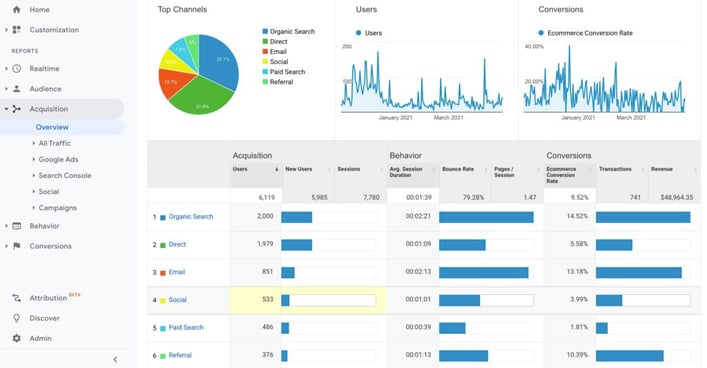In 1994, Hotmail had zero sign-ups. In two and a half years, that number rose to a whopping 30 million.
How?
They attached a link to their website at the bottom of all emails sent with their service.
So, whenever someone sent an email to a friend, colleague, or family member, they were unknowingly engaging in word-of-mouth marketing, a.k.a. organic marketing.
Recipients could click on the link at the bottom to sign up, and continue the cycle in their social circle.
This is a basic illustration of organic marketing. It also demonstrates the potential outcome of a well-executed organic marketing campaign.
Below, you’d find what organic marketing is, how it differs from paid or inorganic marketing, and how you can employ it.
What is organic marketing?
Organic marketing is marketing strategies you don't spend directly on to amplify. This includes social media posts, blog posts, Facebook updates, and LinkedIn articles.
Organic marketing produces four basic results:
- Attracts the attention of your prospects by offering helpful information that solves their problems
- Holds readers’ attention, builds credibility, and keeps you top of mind until they’re ready to purchase
- Turns prospects into loyal customers who can advertise your product to others.
- Creates permanent sources of traffic to your website.
It takes a while to yield results. But once it does, it becomes a gift that keeps on giving.
For instance, an article you write today continues to generate traffic for years, albeit with few updates. And a social media update you put up today continues to pull in traffic endlessly.
Again, an advantage of organic marketing is believability.
Today’s consumers are ad-averse. That’s due to many years of exposure to over-the-top advertisements that either overstate facts or lie outright.
People now hate the feeling of being sold to. It’s the same thing online. According to Hubspot, 91 per cent of online users feel that ads are intrusive.
This explains why 53% of website traffic comes from organic search, and only 15% from paid search, according to BrightEdge report.
Important note, however: although you don’t pay directly to amplify organic content, there are still indirect costs. You’ll spend on tools and hiring writers, and devote time and resources to researching and writing.
Organic marketing vs. inorganic or paid marketing
Paid marketing is the direct opposite of organic marketing.
It encompasses all paid efforts to reach, attract, and engage your ideal customers. That means paid ads, sponsored posts, paid social media ads, paid Google ads, display ads, and many more.
For Google search results, the ones without the "Ad" label are organic listings. This means they’re products of an organic marketing strategy. In contrast, the search listings with the "Ad" label are paid listings—businesses pay to appear there.
Whereas paid marketing is optimized to convert on the spot, organic marketing is solely meant to attract and build brand awareness.
Because of this, the outcomes of sponsored marketing are more likely to be seen right away, whereas those of organic marketing take longer to show results.
Again, organic marketing is judged by the traffic it generates. In contrast, a paid marketing strategy is judged using return on ad spend, conversion rates, impressions generated, and more.
The ingredients of a successful organic marketing strategy
Every successful organic marketing strategy rests on three pillars: consistency, quality, and empathy.
Consistency
To succeed with organic marketing, you must post articles consistently or share social updates continuously. You can’t show up once in a new moon and expect results.
Why?
Because the results of organic marketing—increased brand awareness, customer loyalty, higher rankings on SERPs, and credibility—are borne out of a relationship.
And in the same way a relationship begins after several dates, so does your audience's relationship with your brand require multiple interactions with your content.
Consistency may mean posting twice a day for someone, once a day for another person, or once a week for someone else. It all depends on your industry, audience, and what your competitors are doing.
Media companies may post every hour and publish an article every day, for instance. While posting once a day and publishing 2-4 articles a month can be sufficient for a SaaS company.
Quality
It’s great to show up consistently. But it’s even better to post quality content consistently. That portrays your brand in a positive manner to your audience.
The definition of “quality content” is dependent on your ideal audience. It might be okay to write in a quirky manner for a young audience. But you can’t do the same when writing for a C-suite audience.
So, know your audience first. Then, you can define "quality."
Empathy
Empathy leads to fostering an emotional connection between you and your audience. It shows your audience you understand. It shows you care.
Also, a study by HBR shows that customers who are fully connected emotionally to a brand are 52 percent more valuable.
To infuse empathy into your organic marketing efforts,
- Diagnose the pain points of your audience
- Provide useful and accurate information to solve their problem.
- Don’t just tell readers what to do. Show them how to do it.
Use visuals, analogies, and examples. It shows that you value their time, and are focused on offering help.
- "Speak" at your audience’s level
- Write humanely (not robotic!). Use keywords naturally instead of forcing them into every sentence.
Now that you know the pillars, let’s cover how to develop your organic marketing strategy.
How to develop an organic marketing strategy
Organic marketing can’t be executed in a vacuum. You need a well-designed action plan to guide you to achieving the goals you have in mind. That’s the role of an organic marketing strategy.
So, gear up! And let’s get to the steps of creating an organic marketing strategy.
Evaluate the source of your current traffic
The goal of organic marketing is to attract your ideal audience. So, you must discover the best way to reach them.
And what better way to do that than to engage them on the platforms they frequent?
But how do you find the platforms they frequent?
Start with your website.
Analyse the sources of traffic to your website. Which of them pools the most traffic? Is it your email newsletter? Your social media pages? Or your Youtube channel?
You can use Google search console. Click on reports on the left hand corner. Then click on “acquisition” and select “overview” from the drop down.
You should get something like this:

Then create content for the sources of traffic you have identified.
Other tools you can use include Semrush, Ahrefs, and many more.
Additionally, you should discover how they find content like yours. Perhaps it’s from influencers, reports, industry blogs, or social media. And if it’s social media, is it Facebook? LinkedIn? Or Twitter?
Create content
The next thing is to start creating content such as videos, articles, infographics, white papers, case studies, and many more.
However, you must design a content growth model and a content marketing strategy before you start creating content.
A content growth model predicts how much organic traffic will result from investing in content. And a content marketing strategy provides a roadmap for achieving growth via content.
Also, you can either write the content yourself or sublet it to freelancers.
If you’re subletting, create a well-researched SEO content brief. It eliminates multiple rounds of editing and gives the writer a complete picture of what you want.
Finally, whatever content you create should be timeless (evergreen content), of high quality, result-driven, unique, and scanned through a free plagiarism checker. This will ensure the content's uniqueness and helps you to use 100% original text for your organic marketing. So, you will not only attract but also hold your ideal audience's attention.
Optimize your website to attract traffic
Search engine optimization (SEO) refers to strategies that help your website rank high on search engine result pages (SERPS) and social platforms, leading to more organic traffic.
Organic marketing cannot be done without SEO. That’s why you must optimize your website to be found on search engines.
There are several tips to optimize your website. But the basic ones include:
Use keywords
Use your target keywords in the meta description, alt tags, video descriptions on Youtube, and in social media posts.
But avoid keyword stuffing. Include keywords only if they do not disrupt the flow of the sentence or paragraph.
Lower your page load time
The lower your page loads, the higher your website ranks on SERPs.
So, use small-sized images, (not greater than 200kb), minify CSS, Javascript and HTML, and enable browser caching.
Optimize for mobile
Per Statista, mobile devices have accounted for more than half of web traffic since 2020. And according to Comscore, 69% of users’ media time occurs on smartphones.
For these reasons, Google’s algorithm uses content from the mobile version of your website when indexing. And if the mobile version is poor, you’d be ranked low.
So, make your website mobile-compliant.
Make buttons clickable. Discard text-blocking ads or pop-ups. And don’t overcomplicate your web design.
Measure and improve
You can't improve what you don't measure. Besides, how else will you know if a strategy is working if you don't measure it?
That’s the same with organic marketing. You must consistently measure your organic marketing efforts across the various channels. Then use the data you get to make improvements.
First, decide on your goals: Conversions? Downloads? Or just traffic? Then choose a metric that’s related to the goal. Examples of such metrics include:
- Social media engagement metrics
- Downloads
- Traffic generated
- Social shares
- Leads generated
- Bounce rate
- Dwell time
To measure the metrics, you can use data tools like Google Search Console or Moz. Alternately, you might rely on the built-in analytics dashboard of the social platform.
Remember that the purpose of measuring is to make changes and find ways to improve what is already working.
Grow your social media presence
Having a strong social media presence gives wings to your organic content marketing efforts.
These days, almost everyone is on social media. It has even become the number one channel (above websites) used by marketers.
So…
Did you publish a blog recently or have a podcast feature coming up? Post about it on your social media page.
Do you have a long-form article? Repurpose the subsections into posts on social media.
That way, you’ll drive more traffic to your website.
Before you start posting on social platforms:
- Choose a channel your ideal audience frequents.
For instance, LinkedIn or Twitter would be perfect for a B2B company because most business leaders frequent them.
- Choose a content format that matches the platform.
You don’t want your posts to stand out from other posts. If it’s an Instagram post, make it visual.
- Discover the times your audience is most active, and post within that time period.
For example, posting during work hours when your target audience is mostly workers is ill-advised.
Should you use organic marketing or paid marketing?
The answer is both. Because they work in tandem.
You could, for example, use organic content marketing to attract visitors to your site, then retarget them later using paid ads related to the content they interacted with.
Also, while organic marketing majorly engages current customers and guides them towards a purchase decision, paid marketing gets your brand in front of people who don’t know about you yet.
Generate traffic with organic marketing
Sales is mostly a numbers game: you have a better chance of getting sales when you generate more traffic.
And organic marketing is a cost-efficient way to attract traffic to your website, engage them, and nurture them into customers.



